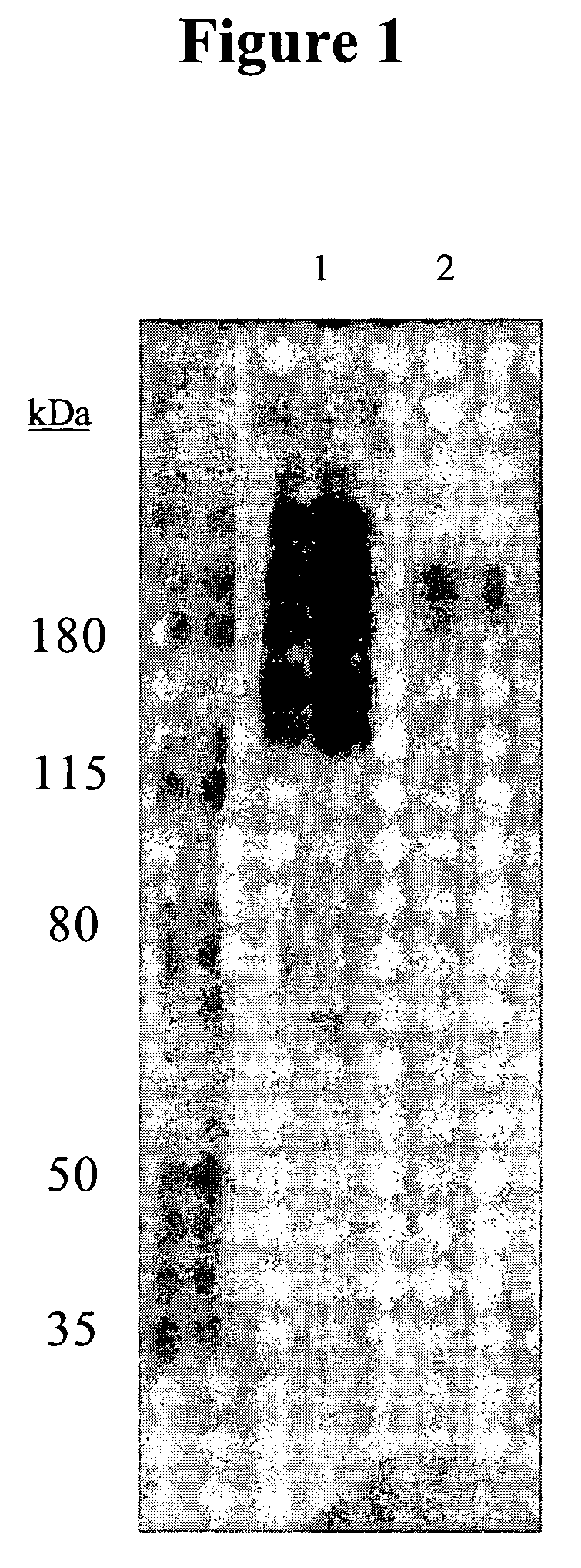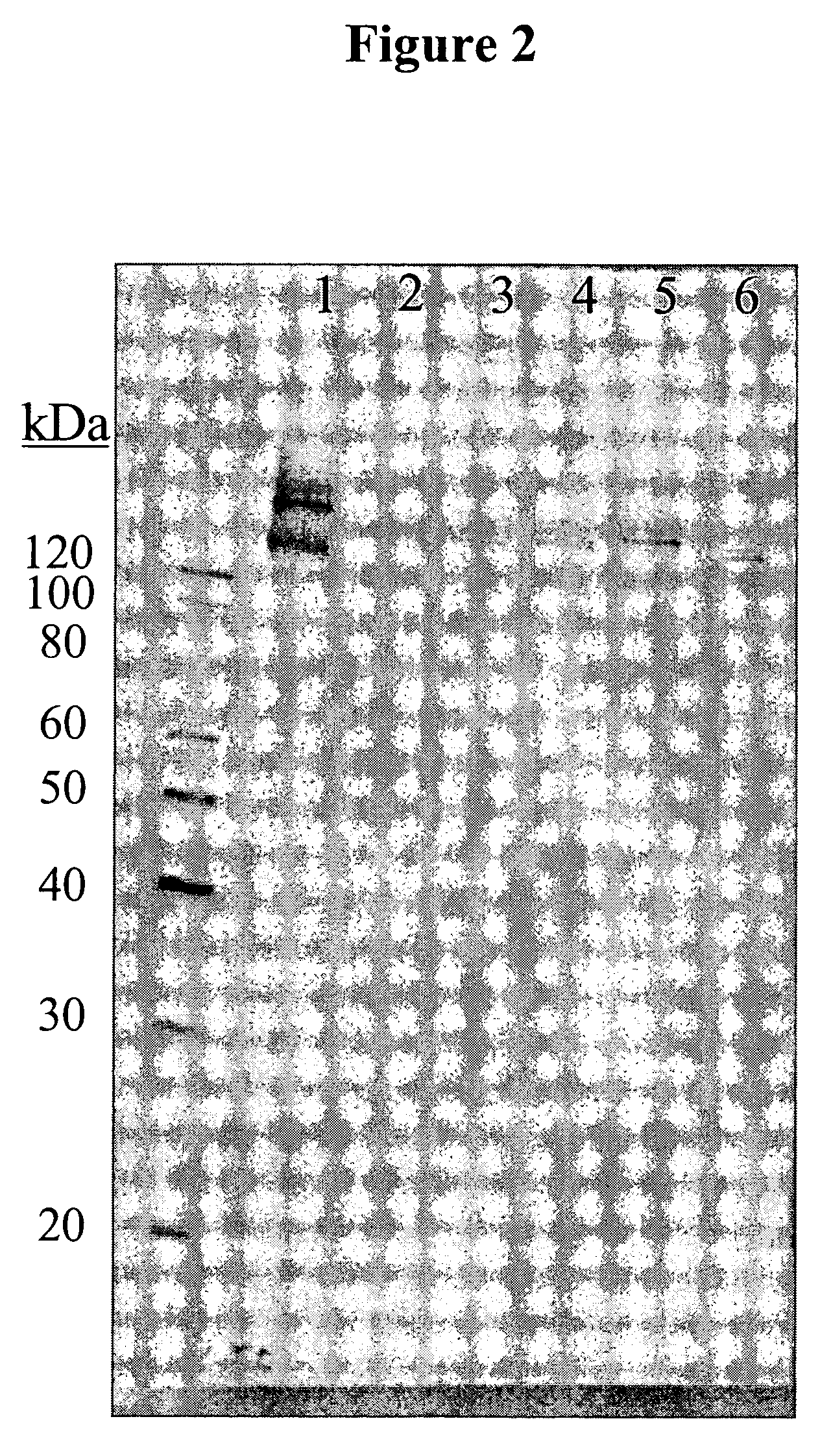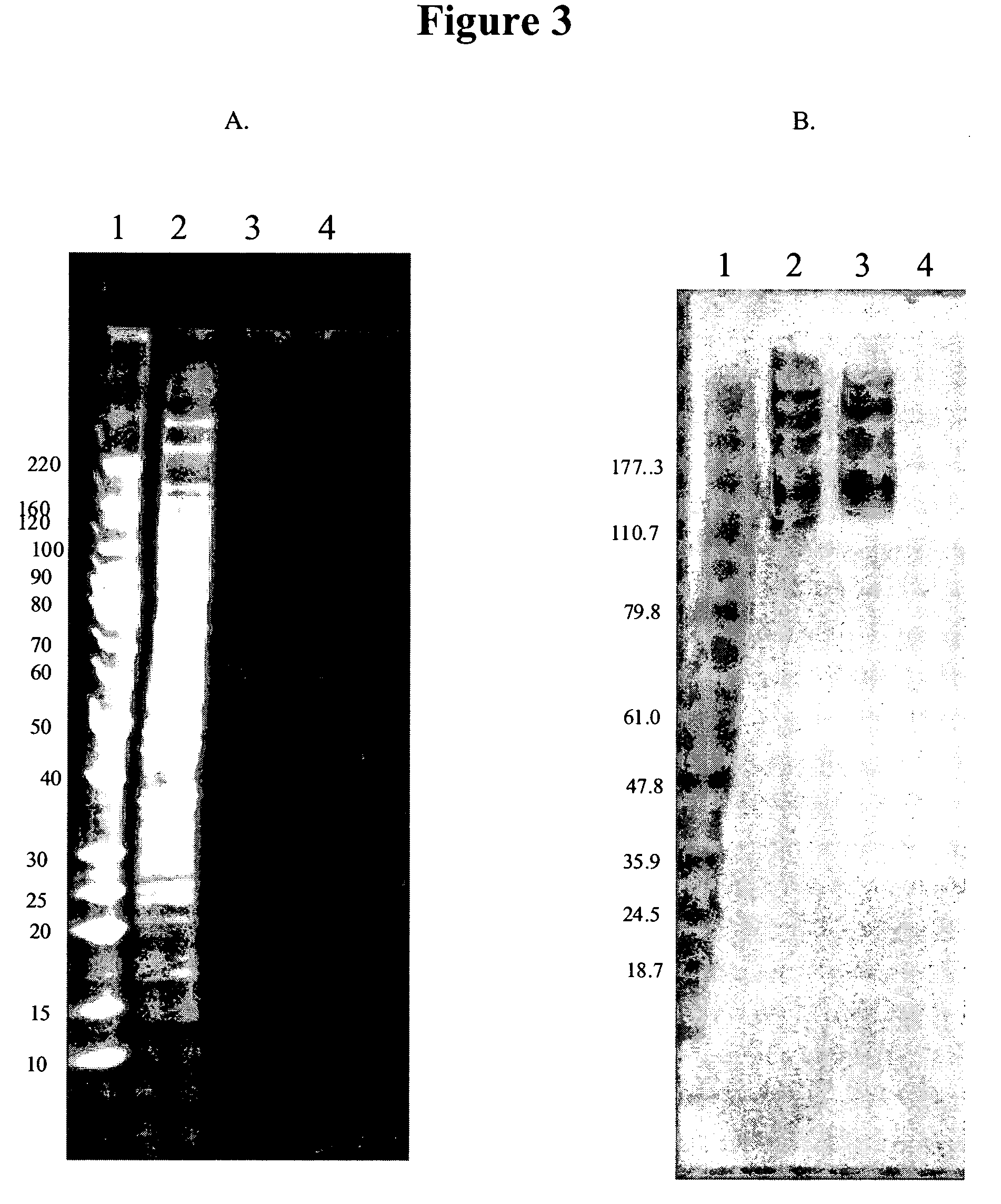Cytotoxicity mediation of cells evidencing surface expression of MCSP
a cytotoxicity and surface expression technology, applied in the field of cancer diagnosis and treatment, can solve the problems of inability to demonstrate the induction of specific antibodies to mcsp, only obtained lysis of melanoma cells with a significantly higher effector/target cell ratio,
- Summary
- Abstract
- Description
- Claims
- Application Information
AI Technical Summary
Benefits of technology
Problems solved by technology
Method used
Image
Examples
example 1
Identification of Binding Proteins by Western Blotting
[0074]To identify the antigen(s) recognized by the antibody 11BD-2E11-2, cell membranes expressing this antigen were subjected to gel electrophoresis and transferred using Western blotting to membranes to determine the proteins detected by this antibody.
1. Membrane Preparation
[0075]Previous work demonstrated binding by FACS of 11BD-2E11-2 to the breast cancer line MDA-MB-231 (MB-231). Previous work also demonstrated 11BD-2E11-2 efficacy against the ovarian cancer cell line OVCAR-3. Accordingly, membrane preparations from these 2 cell lines were used for antigen identification. Total cell membranes were prepared from confluent cultures of MB-231 breast cancer or OVCAR-3 ovarian cells. Media was removed from cell stacks and the cells were washed with phosphate buffered saline. Cells were dissociated with dissociation buffer (Gibco-BRL, Grand Island, N.Y.) for 20 min at 37° C. on a platform shaker. Cells were collected and centrifug...
example 2
Determining Glycosylation of Antigens Bound by 11BD-2E11-2
[0078]In order to determine if the antigen(s) recognized by the antibody 11BD-2E11-2 were glycoproteins, MB-231 membranes were incubated with different combinations of PNGase F, endo-o-glycosidase, sialidase, galactosidase and glucosaminidase. Membranes were separated by SDS-PAGE followed by Western blotting as described with 11BD-2E11-2. FIG. 2 demonstrates the result of 11BD-2E11-2 binding to MB-231 membranes that were incubated in deglycosylation buffer only (Lane 1), in a combination of PNGase F, endo-o-glycosidase, sialidase, galactosidase and glucosaminodase (Lane 2), in a combination of PNGase, endo-o-glycosidase and sialidase (Lane 3), in sialidase only (Lane 4), in endo-o-glycosidase only (Lane 5), and in PNGase only (Lane 6). Treatment of MB-231 membranes with glycosidases does not eliminate binding of 11BD-2E11-2, however a molecular weight shift of the proteins is observed in all lanes, indicating that the antigen...
example 3
Identification of Antigens Bound by 11BD-2E11-2
[0079]The identification of the antigen for 11BD-2E11-2 was carried out by isolating the cognate ligand through immunoprecipitation of solublized membrane gylcoproteins with the antibody. 100 μL of Protein G Dynabeads (Dynal Biotech, Lake Success N.Y.) were washed 3 times with 1 mL of 0.1 M sodium phosphate buffer pH 6.0. 100 μg of 11BD-2E 11-2 in a total volume of 100 μL 0.1 M sodium phosphate buffer pH 6.0 was added to the washed beads. The mixture was incubated for 1 hr with rotational mixing. Unbound antibody was removed and the 11BD-2E11-2 coated beads were washed 3 times with 0.5 mL 0.1 M sodium phosphate pH 7.4 containing 0.1 percent Tween-20. The 11BD-2E11-2 coated beads were washed 2 times with 1 mL 0.2 M triethanolamine pH 8.2. 11BD-2E11-2 was chemically crosslinked to the beads by adding 1 mL of 0.02 M dimethylpimelimidate in 0.2 M triethanolamine pH 8.2 and incubating with rotational mixing for 30 min. ...
PUM
| Property | Measurement | Unit |
|---|---|---|
| MW | aaaaa | aaaaa |
| MW | aaaaa | aaaaa |
| MW | aaaaa | aaaaa |
Abstract
Description
Claims
Application Information
 Login to View More
Login to View More - R&D
- Intellectual Property
- Life Sciences
- Materials
- Tech Scout
- Unparalleled Data Quality
- Higher Quality Content
- 60% Fewer Hallucinations
Browse by: Latest US Patents, China's latest patents, Technical Efficacy Thesaurus, Application Domain, Technology Topic, Popular Technical Reports.
© 2025 PatSnap. All rights reserved.Legal|Privacy policy|Modern Slavery Act Transparency Statement|Sitemap|About US| Contact US: help@patsnap.com



